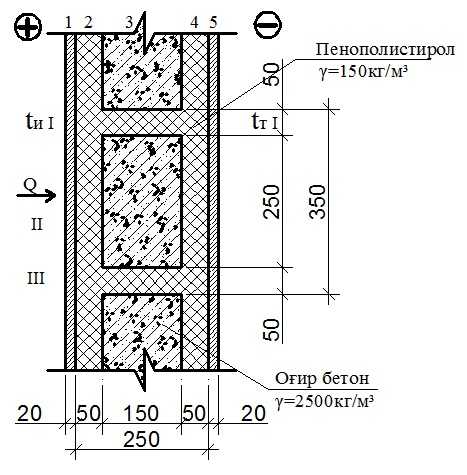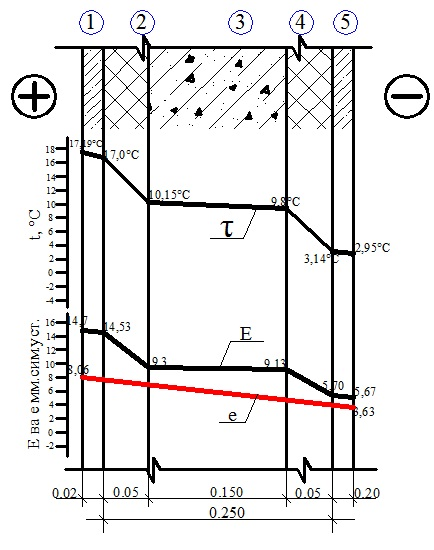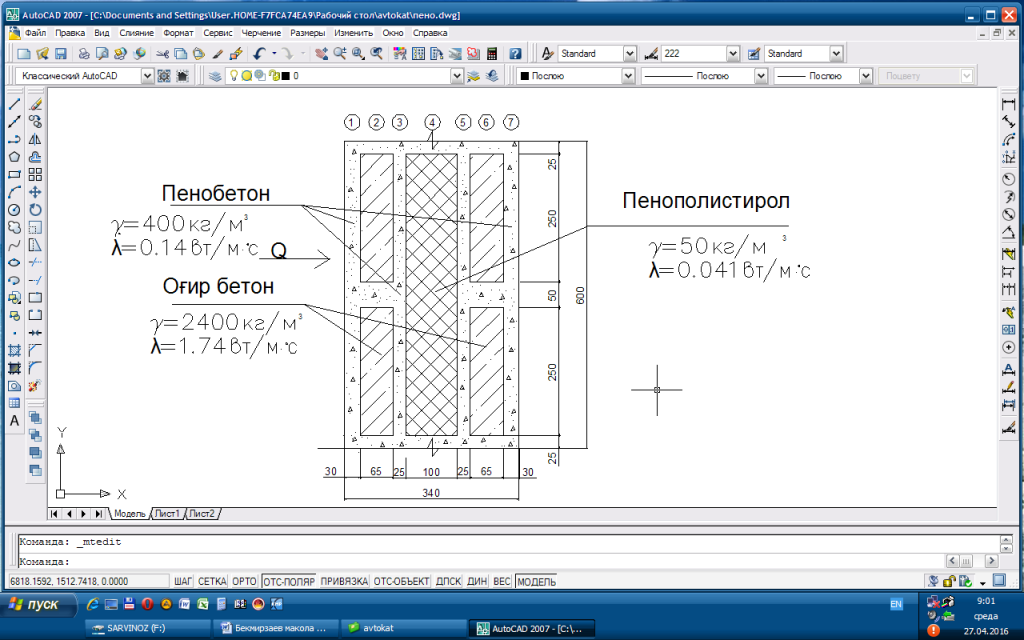
Ways to increase the energy efficiency of buildings and their external barrier structures

Egamova Marguba Turakulovna, teacher;
Matyokubov Bobur Pulatovich, teacher;
Samarkand State Architecture and Civil Engineering University, Uzbekistan.
pulatovich93@gmail.com
Abstract: In this article the results of theoretical and field studies with different thermal design solutions of external walls to improve the energy efficiency of buildings.
Keywords: Natural energy, external barrier construction, polystyrene,thrombus wall, heat-physical
Nowadays, rational use of natural energy resources remains one of the main tasks in all developed countries of the world.
In order to effectively use natural energy sources in Uzbekistan, in the reconstruction and perfect repair of residential, treatment, children's institutions, schools, lyceums, colleges and boarding schools, which are being built and used in accordance with the requirements of KMK 2.01.04-97*, which was adopted in 2011 as amended, their energy in order to increase its efficiency, it is necessary to increase the thermal protection of external barrier structures.[3]
Therefore, in order to increase the energy efficiency of buildings, thermal-physical practical experiments were carried out on external wall samples with different structural solutions in the laboratory of the "Building and Constructions" department of SamDAQU. Some of these are listed below:
In the joint enterprise "OOO SAM ROS KHOLOD" a non-removable form of polystyrene foam was prepared, in the laboratory of the "Building and structures" department of SamDAQU an external wall sample was built and thermal-physical experiments were conducted. this. The experiment was conducted based on the requirements of UzRTS-809-97 "Determining the thermal conductivity of barrier structures" method [4].
Experimental results were compared with theoretical studies.
The scheme of the wall structure is presented in (Fig. 1).
Figure 1. Scheme of non-removable formwork wall construction made of foam polystyrene.
The total thermal conductivity of this structure is Rу =2.49 м2 .(м2. оC)/Вт and the total thermal protection meets the requirements of QMQ 2.01.04-97 *. In addition, as can be seen from Figure 2, condensation moisture does not form in the layers of this structure.
2 - picture. Moisture status of non-removable formwork wall construction of expanded polystyrene
1 - Cement-sand plaster; 2 - Polystyrene; 3 - Cast heavy concrete; 4 - Polystyrene; 5 - Cement-sand plaster; In addition, various studies are being conducted in the field of using solar energy for heating buildings in our Republic. An experimental solar house with a heliosystem of the "Thromb Wall" type is located at 40° latitude in Princeton. Built in (New Jersey, USA), this latitude corresponds to our country.
However, such buildings, i.e. "Tromb wall" type solar buildings with helio system, have not been designed and built in our country. In order to build this type of buildings in the climatic conditions of Uzbekistan, it is necessary to justify them as a result of thermal-physical theoretical and practical experiments. For this reason, we have installed a "Thromb wall" model on the outer wall of the laboratory of the "Building and Construction" department of SamDAQU, and thermal physics research is ongoing.
In order to increase the energy efficiency of buildings with the help of local materials, a constructive solution was developed for the external wall with non-removable formwork made of foam concrete, heat protection increased with foam polystyrene. The advantages of this construction are as follows:
1. The wall structure will be completely restored from local materials; 2. The period of construction of the building will be shortened sharply; 3. The energy efficiency of the building and its exterior will increase; Increases the overall earthquake resistance of the building.
In order to use this construction in practice, it is necessary to theoretically base it on a thermal-physical basis. For this, it is necessary to determine the total heat transfer resistance of the external wall construction, whose calculation scheme is shown in Fig. 3, compare this resistance with the heat transfer resistance given in QMQ 2.01.04-97*, and recommend the effective thickness of the wall. In addition, it is necessary to justify the formation of condensate moisture in the layers of this construction or not using the graphoanalytical method.
Thermal-physical calculations are performed in the following order.
Since the non-removable external wall construction of foam concrete shown in Figure 3 is not homogeneous, we cut it with planes parallel and perpendicular to the direction of heat flow and determine the thermal heat transfer resistance.
Figure 3. Scheme of a non-removable formwork wall construction of foam concrete.
We divide the construction into parts I and II by cutting it with a plane parallel to the direction of heat flow. The first part is made of foam concrete and the second part is made of heavy concrete and expanded polystyrene. We determine the heat transfer resistance for the first part using the following formula.
R_I=δ_1/λ_1 +δ_2/λ_2 +δ_3/λ_3 ; (1)
For thermal physical calculations, we accept the following heat transfer coefficients[3].
1. Foam concrete, Υ_0=400-600 кг/м^3,λ=0,14 Вт/(м^2∙℃) ;
2. Heavy concrete, Υ_0=2400 кг/м^3 ,λ=1,74 Вт/(м^2∙℃) ;
3. Styrofoam, Υ_0=100 кг/м^3,λ=0,041 Вт/(м^2∙℃);
〖 R〗_I=2,428 м^2∙℃/Вт. Surface of the first part F_I=0.05.
The second part of the structure consists of foam concrete, heavy concrete and expanded polystyrene. Its heat transfer resistance. RII=3.298( м2 .оC)/ Вт.
We determine the thermal heat transfer resistance of this structure using the following formula [2].
R_II=(F_I+F_II+F_III+⋯.)/(F_I/R_I +F_II/R_II +F_III/R_III +⋯.) (2)
Here, R_I,R_II,R_III…,- thermal heat transfer resistance of individual layers, м^2℃/Вт; F_I,F_II,F_III…, the surface of individual parts, м^2
The surface of the second part is F_II=0,25..
Wall thermal heat transfer resistance, RII=3.1(5 м2 .оC)/ Вт.
Cutting the construction with a plane perpendicular to the direction of heat flow, 1;2;3;4;5;6; and divide into 7 layers (Fig. 3).
1st and 7th layers of foam concrete〖 R〗_1=R_7=0,214〖(м〗^2∙℃)/Вт; 3 and 5 layers of foam concrete 〖R_3=R〗_5=0,178( м^2∙℃)/Вт; 4th layer expanded polystyrene R_4=0,10/0,041=2,439 (м^2∙℃)/Вт;; Since part 2 is not homogeneous, we determine the average heat transfer coefficient of the construction using the following formula. [1.2]
λ_ўр (λ_I xF_I+λ_II xF_II+λ_III xF_II)/(F_I+F_II+F_III )=1.473 Вт/(м^2∙℃),
Here, λ_I,λ_II… is the thermal conductivity coefficient of the materials that make up the individual layers, Вт/(м^2∙℃) ; F_I,F_II… surfaces of individual layers,
Then R_2=R_6=0,044 ( м^2∙℃)/Вт.
So, R_⊥=R_I+R_2+R_3+R_4+R_5+R_6+R_7=3,311 〖(м〗^2∙℃)/Вт.
The heat transfer resistance of a non-homogeneous structure is determined using the following formula. [1.2]
R=(R_II+〖2R〗_⊥)/3 = (3,157+2x 3,311)/3=3,259 〖(м〗^2∙℃) / Вт,
We determine the total heat transfer resistance of a non-homogeneous wall structure made of foam concrete.
R_ум=R_и+R+R_T=0,114+3,259+0,043=3,416 〖(м〗^2∙℃)/Вт;
Therefore, the total heat transfer resistance of the non-removable formwork wall construction made of foam concrete that we recommend meets all the requirements of the level of heat protection specified in QMQ 2.01.04-97*.
Conclusion. The following can be concluded from the above theoretical and practical studies:
1. As a result of the calculations, it was found that the thermal protection of the non-removable formwork wall construction made of foam concrete is sufficient for the conditions of Uzbekistan and meets the requirements of QMQ 2.01.04-97*;
2. Heat transfer resistance of non-removable formwork wall construction made of foam concrete, thickness 38 cm. and it is 4.9 times greater than the heat transfer resistance of a brick wall with a density of 1600 kg/m3 and 1.3 times greater than the heat transfer resistance of a non-removable formwork wall structure made of polystyrene foam;
3. If this wall construction is based on thermal-physical practical experiments, it will provide an opportunity to build various energy-efficient buildings.
References
Шукуров Ғ.Ш., Бобоев С.Н. Архитектура физикаси 1-қисм. Дарслик Қурилиш иссиқлик физикаси-Тошкент, Меҳнат, 2005 й..160 б.
Шукуров Ғ.Ш.,Исломова Д.Ғ. Қурилиш физикаси. Дарслик - Самарқанд,. 2015 й., 217 б.
ҚМҚ 2.01.04-97* Қурилиш иссиклик техникаси.-Тошкент, 2011й.
Ўз РСТ 809-97 “Тўсиқ конструкцияларининг иссиқлик узатишга қаршилигини аниқлаш” Т., 1997й.
Bolikulovich K. M., Pulatovich M. B. HEAT-SHIELDING QUALITIES AND METHODS FOR ASSESSING THE HEAT-SHIELDING QUALITIES OF WINDOW BLOCKS AND THEIR JUNCTION NODE WITH WALLS //Web of Scientist: International Scientific Research Journal. – 2022. – Т. 3. – №. 11. – С. 829-840.
Тулаков Э.С., Бўронов Ҳ., Матёқубов Б.П., Абдуллаева С. А.. Кам қаватли турар-жой бинолари ертўла деворларининг иссиқлик изоляция қатлами қалинлигини ҳисоблаш. //Me’morchilik va qurilish muammolari Проблемы архитектуры и строительства.Samarqand 2020. №2. -С.41-45.
Pulatovich, M. B. . (2021). Energy Efficient Building Materials for External Walls of Residential Buildings Physical Properties of Heat. International Journal of Culture and Modernity, 9, 1–11. Retrieved from https://ijcm.academicjournal.io/index.php/ijcm/article/view/67
Тулаков Э.С., Матёқубов Б.П.. Thermal Insulation Of The Foundation Walls Of Buildings And Calculation Of ItsThickness. THE AMERICAN JOURNAL OF ENGINEERING AND TECHNOLOGY (TAJET) SJIF-5.705 DOI-10.37547/tajet Volume 3 Issue 04, 2021 ISSN 2689-0984 The USA Journals, USA www.usajournalshub.com/inde x.php/tajet -С.70-78
Pulatovich, M. B. . (2021). Analysis of Underground Projects of Energy-Efficient Residential Buildings. International Journal of Culture and Modernity, 9, 12–18.Retrieved from https://ijcm.academicjournal.io/index.php/ijcm/article/view/68
Inatillayevich, G.O. and Pulatovich, M.B. 2021. Analysis of Underground Projects of Energy Efficient Low-Rise Residential Buildings Built on Highly Flooded Soils. International Journal on Integrated Education. 4, 9 (Sep. 2021), 96-102. DOI:https://doi.org/10.31149/ijie.v4i9.2156.
Pulatovich, M. B. ., & Innatillayevich, G. O. . (2021). Laboratory Experimental Studies on the Properties of Highly Sedimentary Lyos Soils when their Moisture Changes Over Time. European Journal of Life Safety and Stability (2660-9630), 8, 91-98. Retrieved from http://ejlss.indexedresearch.org/index.php/ejlss/article/view/119
Pulatovich, M. B. ., & Shodiyev, K. . (2021). Thermal Insulation of Basement Walls of Low-Rise Residential Buildings and Calculation of its Thickness. International Journal of Culture and Modernity, 9, 19–27. Retrieved from https://ijcm.academicjournal.io/index.php/ijcm/article/view/69
Матёкубов, Бобур Пўлатович, and Сарвара Музаффаровна Саидмуродова. "КАМ СУВ ТАЛАБЧАН БОҒЛОВЧИ АСОСИДАГИ ВЕРМИКУЛИТЛИ ЕНГИЛ БЕТОНЛАР ТЕХНОЛОГИЯСИНИ ҚЎЛЛАНИЛИШИ." INTERNATIONAL CONFERENCES. Vol. 1. No. 15. 2022.
Pulatovich, M. B. . (2021). Energy Efficient Building Materials for External Walls of Residential Buildings Physical Properties of Heat. International Journal of Culture and Modernity, 9, 1–11. Retrieved from https://ijcm.academicjournal.io/index.php/ijcm/article/view/67
Тулаков Э.С., Иноятов Д., Қурбонов А.С., Матёқубов Б.П.. Бинолар-нинг ертўла деворларини иссиқлик изоляциялаш ва унинг қалинлигини ҳисоблаш. //Me’morchilik va qurilish muammolari Проблемы архитектуры и строительства.Samarqand 2020. №4.(2-қисм) -С.29-32.
Матёкубов, Б. П., & Саидмуродова, С. М. (2022). КАМ СУВ ТАЛАБЧАН БОҒЛОВЧИ АСОСИДАГИ ВЕРМИКУЛИТЛИ ЕНГИЛ БЕТОНЛАР ТЕХНОЛОГИЯСИНИ ҚЎЛЛАНИЛИШИ. INTERNATIONAL CONFERENCES, 1(15), 103–109. Retrieved from http://researchedu.org/index.php/cf/article/view/319
Inatillayevich G. O., Pulatovich M. B. Analysis of Underground Projects of Energy Efficient Low-Rise Residential Buildings Built on Highly Flooded Soilshttps //doi. org/10.31149/ijie. v4i9. – Т. 2156.
Matyokubov , B. P., & Saidmuradova, S. M. (2022). METHODS FOR INVESTIGATION OF THERMOPHYSICAL CHARACTERISTICS OF UNDERGROUND EXTERNAL BARRIER STRUCTURES OF BUILDINGS. RESEARCH AND EDUCATION, 1(5), 49–58. Retrieved from http://researchedu.org/index.php/re/article/view/364.
https://scholar.google.com/citations?view_op=view_citation&hl=ru&user=jhldcIoAAAAJ&citation_for_view=jhldcIoAAAAJ:RHpTSmoSYBkC.
Носирова С. А., Рустамова Д. Б., Эгамова М. Т. ЭНЕРГИЯТЕЖАМКОР УЙЛАР-ЎЗБЕКИСТОННИНГ ЯҚИН ЙИЛЛАРДАГИ ЭНГ АСОСИЙ ШИОРИ //Журнал Технических исследований. – 2021. – Т. 4. – №. 2.

